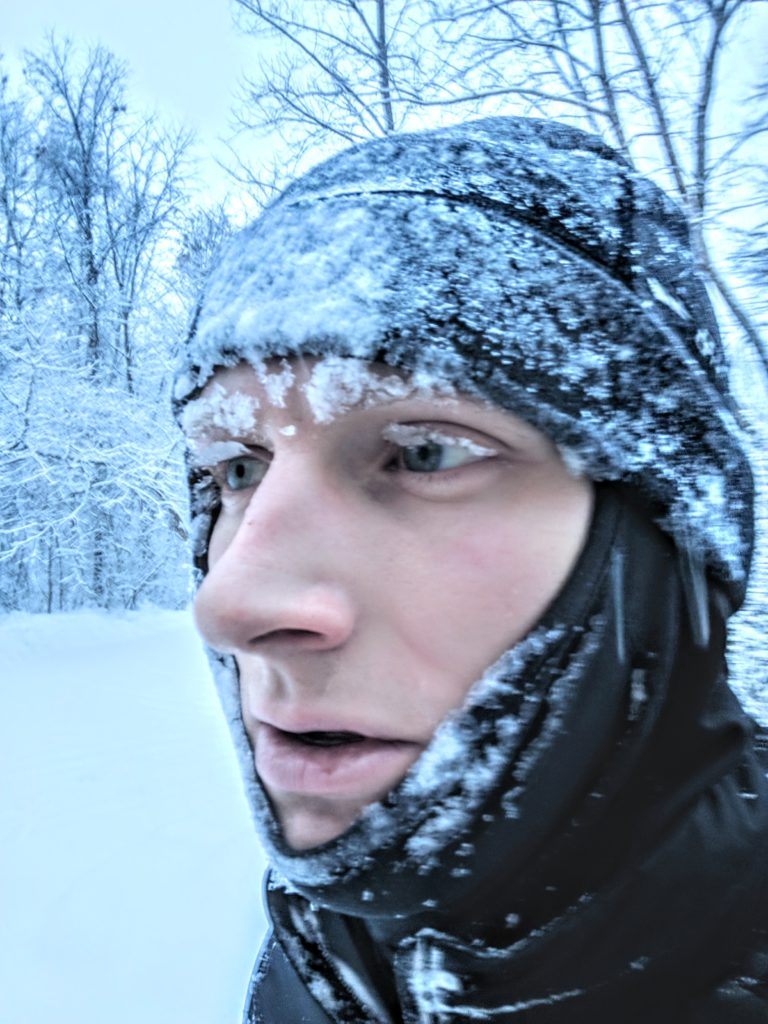Running in a Winter Wonderland
If you’ve landed here looking for advice on winter running, you’ve found your blog and your people. Yes, we are a special kind of crazy. Let’s bond over some snot-cicles, frozen lashes, and crystal beards (though neither of us have ever had a real beard…).

While many of us have run for years in frigid and snowy temps, we have to actively remind ourselves how to run in the winter wonderland. In this blog post we will go over how to navigate adverse conditions, dress for the winter run, and find alternatives to outdoor training (because being healthy and safe is better than being tough!).
Disclaimer: We may receive a small commission from purchases made through links in this post. This has not influenced our recommendations and it will not cost you extra to navigate to Amazon through our site.

Navigating Adverse Conditions
Just this past weekend, a friend and I ran on our normal long-run route, but it was different. Overnight it became icy and uneven in places.
Shalane Flanagan once said, “You don’t take a Ferrari off-roading.” While I can’t claim to be as fine-tuned a vehicle as a Ferrari, I may be a sporty Corolla. The same idea applies. Unless I have been working diligently to run on these types of uneven ground, I should proceed with extreme caution.
If you find yourself navigating adverse conditions, here are some practical tips:

Shorten your stride.
While shortening your stride is almost always a good tactic for running long distances, it is especially important to focus on this element of form with uneven or ambiguous surfaces. The reason being if you overstride and your foot lands in front of you, the chances of injury are much higher. Shortening your stride length will help your foot fall more naturally underneath you which gives you the greatest opportunity to regain central balance.
It’s also significantly more economic and generally sound advice for any time/place you’re running.
Go easy on the push off.
The harder the push off, the harder the fall. If you happen to step on a slick spot with great force, it will propel you with… great force. Ouch! Light and quick steps are better than aggressive, powerful ones (or lethargic, lazy ones, if we’re being honest).
Run Hands Free
Resist holding anything while you are running, including bottles or a cell phone (I am guilty of this as you probably can tell if you follow us on Instagram). The practical reason is that you can better catch yourself if you fall.

Dress for the Run
It is so much easier to get out the door if we are a little overdressed. Training is different than racing. In races, we will more likely wear less knowing we will warm up. During training, proper gear will help motivate to get outside.

Protect your extremities.
Hands, ears, and feet are important areas to insulated during a chilly run. I don’t know any runner who has too many pairs of gloves. They get disgusting and need to be washed routinely. Zach also has a nifty pair of wind resistant base-layer briefs. He highly recommends them.
Layer up.
I don’t mean to brag, but I think I can accurately praise my fellow Michiganders that they know how to layer. You can always shed layers as you warm up. Good running layers include: moisture wicking base layer, half-zip or full zip, outer shell, and maybe a vest. You won’t need all of those all the time, but that is a solid ordering of layers for the distance runner.
Don’t forget your face.
“I can’t feel my face when I’m with you…” I could sing this to winter on the regular. Breathable neck warmers (like Buff) can be pulled over the face, valuable for varying body temperatures and volatile outdoor conditions. You can also get face masks specific to running.

RUNNING HACK: You can use vaseline to keep your face a little warmer and protect your skin from the wind. Similarly, vaseline can help your lips. Please, take it from me… I have split my lips to painful dysfunction. Protect your lips.
We recently added our complete Gear Bag due to our requests for recommendations. It’s the big list of all our favorite running stuffs (tech, shoes, apparel, nutrition, recovery, etc.). Browse the winter section for a more extensive list of gear and clothing we use.

Alternatives to Outdoor Training
Running alternatives include, of course, the treadmill if you are fortunate enough to have one or have access to one. Your local universities may sell memberships to use their indoor track facilities. We have found a great benefit to having a gym membership, especially for the childcare advantage.

A more extensive conversation on cross training will happen in the near future. A few of our favorites include:
- Cycling
- Aqua Jogging
- Zero Running
If you are stuck, snowed in, and can’t do a darn thing, consider a rest day with a focus on mobility and strength.
Final thoughts

Running in a winter wonderland can be truly wonderful, but we have to respect the elements. Concise running form, proper gear, and a solid back up plan for exercise will help you train successfully through the (many) winter months.
Have a thought? We would love to hear it. Thanks to Joe Swinehart of Lansing, Michigan for reaching out with questions about running in the winter.

As always, thanks for reading! We welcome comments. Stay warm, friends!











Leave a Reply
Want to join the discussion?Feel free to contribute!